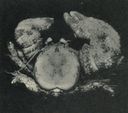Galatheoidea
Galatheoidea
Classification
- Phylum: Arthropoda
- Subphylum: Crustacea
- Class: Malacostraca
- Superorder: Eucarida
- Order: Decapoda
- Infraorder: Anomura
- Superfamily: Galatheoidea
Pronunciation
How to pronounce Galatheoidea: //ˌɡæləˈθiːɔɪdiə//
These audio files are automatically generated. While they are not always 100% accurate, they are a good starting point.
Images






Summary
Galatheoidea is a diverse superfamily of decapod crustaceans, encompassing a variety of species known as porcelain crabs and squat lobsters, which have adapted to a wide range of marine environments since the Middle Jurassic period.
Physical Characteristics
Galatheoidea are known for their distinctively shaped bodies, which often exhibit a flattened appearance. They typically have long, slender antennae, and their limbs may be adapted for a swimming lifestyle, particularly in squat lobsters.
Identification Tips
To identify members of the superfamily Galatheoidea, look for their unique body morphology, including a relatively narrow thorax and specially adapted legs for swimming in squat lobsters. The flat carapace and differences in coloration can also assist in identification.
Habitat
Galatheoidea primarily inhabit marine environments, often found in benthic zones ranging from shallow coastal waters to deeper offshore habitats.
Distribution
This superfamily is distributed worldwide, with their presence in various oceanic regions, especially in deeper waters and continental slopes.
Diet
They are typically omnivorous, feeding on a variety of organic materials, including algae, detritus, and small invertebrates.
Life Cycle
Galatheoidea exhibit a typical crustacean life cycle, beginning with eggs that hatch into larval stages, which undergo several molts before reaching maturity.
Reproduction
Reproductive strategies vary among species, but they generally involve external fertilization with females carrying fertilized eggs in specialized structures until they hatch.
Predators
Common predators include larger fish, crabs, and other marine animals that prey on smaller crustaceans.
Ecosystem Role
As both prey and scavengers, members of Galatheoidea play significant roles in their ecosystems, contributing to nutrient cycling and energy flow.
Economic Impact
Some species are harvested for food and may be important for local fisheries in various regions.
Collecting Methods
- Trap fishing
- Hand collection
- Dredging
Preservation Methods
- Freezing
- Alcohol preservation
- Fixation in formaldehyde
Evolution
The Galatheoidea superfamily has a fossil record dating back to the Middle Jurassic, indicating a long evolutionary history and adaptation to various marine environments.
Misconceptions
Some may confuse squat lobsters with true lobsters due to their similar appearance, but they are categorized in different taxonomic groups and exhibit different morphological traits.
Tags
- Galatheoidea
- Crustaceans
- Decapods
- Marine Biology